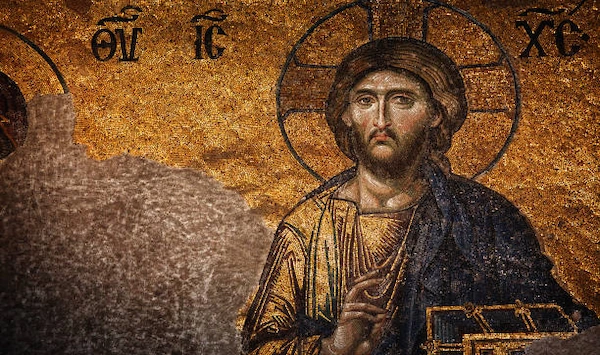
The Revelation of Hidden Wisdom
Among the treasures unearthed at Nag Hammadi in 1945—thirteen leather-bound codices buried beneath Egyptian sands for nearly two millennia—few texts illuminate the spiritual landscape of Gnosticism with the philosophical brilliance of The Sophia of Jesus Christ. This remarkable dialogue between the resurrected Christ and his disciples represents not merely another apocryphal gospel, but a profound metaphysical treatise that challenges conventional theological assumptions about knowledge, divinity, and the nature of existence itself.
The text opens with an arresting scene: Christ appears “not in his previous form, but in invisible spirit,” manifesting before his disciples as “a great angel of light.” This luminous apparition speaks not of faith or ritual observance, but of something more fundamental: “I have come to teach you about knowledge; for it is through knowledge that you will be saved.” With these words, the text establishes its central thesis—that gnosis (knowledge) rather than pistis (faith) constitutes the true path to spiritual liberation.
What distinguishes The Sophia of Jesus Christ within the Gnostic corpus is its intricate weaving of cosmological revelation with the feminine divine principle, articulated through the figure of Sophia (Wisdom). While numerous Gnostic texts reference Sophia, this manuscript provides one of the most philosophically sophisticated explorations of her nature and significance within the divine economy.
Origins and Historical Context
The Sophia of Jesus Christ exists in two manuscript versions: a Coptic translation discovered at Nag Hammadi (Codex III) and fragments of a Greek version found at Oxyrhynchus. Scholarly analysis suggests the original composition dates to the late second or early third century CE, emerging during a period of intense theological ferment within early Christianity.
What makes this text particularly fascinating from a historical perspective is its relationship to another Gnostic work, Eugnostos the Blessed. Careful textual comparison reveals that The Sophia of Jesus Christ appears to be a Christianized adaptation of Eugnostos, transforming a philosophical monologue into a dialogue between Christ and his followers. This literary transformation exemplifies the complex interweaving of philosophical traditions that characterized Gnostic thought, drawing from Platonic, Jewish, and emerging Christian sources to create a distinct theological vision.
The historical context that produced this text was one of competing truth claims within early Christianity. As orthodox formulations began to crystallize around apostolic succession and institutional authority, Gnostic communities advocated for direct spiritual knowledge as the authentic Christian inheritance. The Sophia of Jesus Christ represents a sophisticated articulation of this alternative vision—one that would eventually be marginalized as heretical but which offers invaluable insights into the diversity of early Christian thought.
Cosmological Vision
The cosmology presented in The Sophia of Jesus Christ unfolds through a series of revelatory disclosures, beginning with the ineffable source of all existence—the Forefather or unbegotten Father—who exists in “light which no eye can behold.” From this primordial source emanates a complex hierarchy of divine beings, or aeons, forming what Gnostics called the pleroma (fullness).
This cosmological system bears the influence of Middle Platonic philosophy, particularly in its conception of graduated levels of reality emanating from a transcendent first principle. However, the text transforms abstract philosophical concepts into a dynamic narrative of divine self-revelation:
“The Immortal Man revealed aeon after aeon… Then each aeon was emptied out, one by one, so that they might all come from the One and the same source. For from this source they were all emitted, as well as revealed, together with their powers.”
At the heart of this cosmological drama stands Sophia, whose desire to comprehend the unknowable Father precipitates a crisis within the divine realm. This “fall” of Sophia—her unauthorized attempt to know the unknowable—results in the creation of an imperfect material world governed by ignorance. Her story thus serves as a cosmological explanation for the existence of evil and suffering in the world.
What distinguishes this cosmological narrative from similar accounts in other Gnostic texts is its philosophical subtlety. Rather than portraying the material world as inherently evil, The Sophia of Jesus Christ presents it as a consequence of misdirected desire for knowledge—a metaphysical error rather than moral corruption. The text thus offers a nuanced theodicy that locates the origin of suffering not in human sin, but in the structure of reality itself.
The Nature and Role of Sophia
The figure of Sophia represents the centerpiece of this Gnostic text’s theological innovation. Unlike the static personification of wisdom found in Biblical texts like Proverbs, the Sophia of Gnostic thought embodies a complex divine drama that mirrors humanity’s own spiritual predicament.
Sophia’s nature in this text is fundamentally paradoxical—she is simultaneously a divine aeon within the pleroma and the source of cosmic imperfection. This duality reflects the Gnostic understanding of humanity’s condition: possessing a divine spark while trapped in material existence. As the text states: “She became the mother of everything, for she existed before them all, the mother-father as the first man.”
This androgynous description (“mother-father”) points to another significant aspect of Sophia’s portrayal—her transcendence of conventional gender categories. While described primarily in feminine terms, Sophia also manifests masculine qualities, suggesting that at the highest levels of spiritual reality, gender distinctions dissolve into a more fundamental unity.
Sophia’s role within the divine economy is multifaceted:
- Mediator: She bridges the unbridgeable gap between the ineffable Father and creation.
- Creator: Through her fall and subsequent redemption, she participates in the creative process.
- Redeemer: Her journey from ignorance to enlightenment provides the paradigm for human salvation.
- Revealer: As embodied Wisdom, she reveals hidden knowledge to those capable of receiving it.
What makes the text’s treatment of Sophia particularly valuable is its psychological depth. Her desire for knowledge, her suffering in ignorance, and her ultimate redemption through enlightenment offer a profound allegory for the human spiritual condition. The text thus transforms abstract metaphysical speculation into an emotionally resonant narrative of spiritual transformation.
Gnosis as Salvific Knowledge
At the philosophical core of The Sophia of Jesus Christ lies its distinctive soteriology—its understanding of salvation through knowledge. Unlike orthodox Christianity, which emphasized faith in Christ’s sacrificial death, this Gnostic text presents salvation as cognitive transformation, an awakening to truth that liberates the divine spark within from material bondage.
“Whoever has ears to hear about the infinities, let him hear,” Christ declares in the text, articulating a fundamental Gnostic principle: that spiritual truth is accessible only to those who possess the capacity for deeper understanding. This epistemological elitism reflects the Greek philosophical distinction between doxa (opinion) and episteme (knowledge), suggesting that true spiritual insight transcends conventional religious belief.
The knowledge offered in The Sophia of Jesus Christ operates on multiple levels:
- Cosmological knowledge: Understanding the true structure of reality.
- Anthropological knowledge: Recognizing humanity’s divine origin and nature.
- Eschatological knowledge: Comprehending the ultimate purpose and destiny of existence.
What distinguishes this conception of knowledge from mere intellectual understanding is its transformative character. True gnosis involves not simply knowing about reality but participating in it directly. As the text states: “They are not separate from him, but are like the shadow of light, for they are subject to him.” This participatory epistemology suggests that genuine knowledge involves a form of spiritual union with what is known.
The salvific function of knowledge in this text operates through recognition—specifically, the recognition of one’s true divine nature beneath the veil of material existence. “Those who know the Father in pure knowledge,” the text declares, “will depart to the Father.” This recognition constitutes not merely intellectual assent but existential realization, a radical shift in consciousness that liberates the knower from ignorance.
Dualism and the Material World
The cosmological system presented in The Sophia of Jesus Christ evidences the characteristic Gnostic dualism between spirit and matter, light and darkness, knowledge and ignorance. However, this text articulates this dualism with unusual philosophical sophistication, avoiding simplistic moral condemnation of the material realm.
The material world in this text emerges not through the malevolence of an evil demiurge, as in some Gnostic systems, but through Sophia’s incomplete understanding: “She wanted to give birth by herself, without her consort; and her product was nothing like her mother, because it had another form.” This description suggests that material existence represents not evil per se, but incompleteness—a shadow or reflection of true reality rather than its antithesis.
This nuanced dualism has profound implications for understanding human existence. The human predicament stems not from moral corruption but ontological confusion—a forgetting of our true nature and origin. As the text states: “Those who say they will die first and then rise are in error. If they do not first receive the resurrection while they live, when they die they will receive nothing.”
What makes this dualistic vision distinctive is its epistemological focus. The primary contrast is not between good and evil but between knowledge and ignorance. Material existence constitutes a state of forgetting rather than sin, and salvation involves remembering rather than forgiveness. This conception transforms traditional religious morality into a more fundamental metaphysical awakening.
Philosophical Anthropology
The anthropology (understanding of human nature) presented in The Sophia of Jesus Christ reflects Gnosticism’s distinctive three-fold division of humanity:
- Pneumatics (spiritual): Those possessing the divine spark who are capable of receiving gnosis.
- Psychics (soulish): Those occupying an intermediate position who might achieve partial salvation.
- Hylics (material): Those entirely identified with material existence who cannot comprehend spiritual truth.
This tripartite division reflects the influence of Platonic philosophy, particularly its distinction between reason, spirit, and appetite. However, the text transforms these philosophical categories into existential possibilities, suggesting that one’s spiritual status depends not on predetermined nature but on one’s relationship to knowledge.
What makes this anthropology particularly significant is its implications for understanding human potential. Unlike orthodox Christianity, which emphasized universal human sinfulness and the need for grace, The Sophia of Jesus Christ portrays humanity as inherently divine but unconscious of its true nature: “The perfect Savior said: ‘I want you to know that all men born on earth from the foundation of the world until now are dust.'” This startling statement suggests not human worthlessness but ontological confusion—identification with material existence rather than spiritual reality.
The text thus presents a radical vision of human identity as fundamentally divine rather than created: “Whoever has come to know himself has already achieved knowledge about the depth of all things.” This statement echoes the famous Delphic maxim “know thyself,” but transforms it into a principle of cosmic significance—self-knowledge constitutes knowledge of the divine.
Reinterpreting Biblical Narratives
The Sophia of Jesus Christ engages in a sophisticated reinterpretation of biblical narratives, transforming familiar stories and concepts into vehicles for Gnostic insight. This hermeneutical strategy—reading esoteric meanings into canonical texts—characterizes much of Gnostic literature, but achieves particular sophistication in this work.
The Genesis creation account undergoes radical transformation in this text. Rather than depicting creation as the good work of a sovereign deity, it portrays the material world as an unintended consequence of Sophia’s incomplete understanding. Adam and Eve appear not as historical figures but as archetypal representations of humanity’s divine origin and material entrapment.
Similarly, Christ’s role undergoes significant reinterpretation. Rather than emphasizing his sacrificial death, the text presents him primarily as a revealer of hidden knowledge: “I am the remembrance of the pleroma.” This statement transforms the historical Jesus into a cosmic principle of enlightenment, his significance lying not in atoning sacrifice but in revelatory function.
What makes these reinterpretations particularly noteworthy is their philosophical coherence. Rather than arbitrary allegorization, they reflect a systematic metaphysical vision that reads biblical narratives as symbolic expressions of deeper spiritual truths. This approach to scripture—treating it as encoded wisdom requiring decipherment rather than literal history—anticipates modern hermeneutical approaches that recognize the multivalent nature of religious texts.
The Feminine Divine Principle
Perhaps the most radical theological innovation in The Sophia of Jesus Christ is its integration of feminine imagery into the divine nature. While orthodox Christianity increasingly emphasized God’s paternal characteristics, this text presents divinity as transcending gender distinctions while incorporating both masculine and feminine principles.
Sophia’s prominent role indicates more than token acknowledgment of femininity—it suggests that wisdom itself possesses inherently feminine characteristics. As the text states: “She became the womb of everything, for it is she who is prior to them all, the mother-father, the first man, the holy spirit, the thrice-male, the thrice-powerful, the thrice-named androgynous one.”
This remarkable passage reveals several important aspects of how the text conceives the feminine divine:
- Androgyny as transcendence: Ultimate reality transcends gender distinctions while incorporating both.
- Creative capacity: Feminine divinity possesses generative power (“womb of everything”).
- Primordial status: Sophia exists “prior to them all,” suggesting ontological priority.
- Integration with traditional concepts: The feminine principle integrates with familiar religious concepts (Holy Spirit, First Man).
What makes this portrayal particularly significant is its challenge to patriarchal religious systems. By elevating Sophia to cosmic significance, the text suggests that divine nature inherently includes feminine characteristics—wisdom, receptivity, creativity—rather than exclusively masculine qualities of power, authority, and judgment.
This theological vision has profound implications for understanding spiritual practice. If divinity itself incorporates feminine principles, then spiritual development must likewise integrate traditionally feminine virtues rather than privileging masculine qualities alone. The text thus implicitly critiques religious systems that marginalize women and feminine spiritual expressions.
Spiritual Practices and Ethics
While primarily concerned with metaphysical revelation, The Sophia of Jesus Christ also addresses practical spiritual development. Unlike orthodox texts that emphasize ethical rules or ritual observances, this work presents spiritual practice primarily as contemplative discipline aimed at awakening inner knowledge.
The text describes this contemplative practice through various metaphors:
- Ascent: Rising above material preoccupations to contemplate higher realities.
- Awakening: Emerging from unconsciousness to spiritual awareness.
- Remembering: Recalling one’s divine origin and nature.
- Seeing: Developing spiritual perception beyond physical sight.
As Christ instructs his disciples: “Raise your eyes to the light. Remember your fullness.” This simple directive encapsulates the text’s practical spirituality—redirecting attention from material concerns to spiritual reality and recollecting one’s divine nature.
What distinguishes this spiritual approach is its psychological sophistication. Rather than demanding blind obedience to external authorities, it encourages inner transformation through contemplative discipline. This approach reflects Gnostic Christianity’s integration of Greek philosophical practices (particularly Platonic and Stoic) with Jewish and Christian spiritual traditions.
The ethical implications of this spirituality diverge significantly from orthodox approaches. Rather than emphasizing moral rules, the text presents ethics as alignment with one’s true nature. As one comes to recognize one’s divine origin, right action flows naturally from this recognition rather than from conformity to external commands. This internalization of ethics reflects the influence of Hellenistic philosophical schools, particularly Stoicism’s emphasis on living according to nature.
Comparisons with Other Religious Traditions
The Sophia of Jesus Christ enters into implicit dialogue with several religious traditions, both affirming and challenging their central tenets. These comparative elements reveal the text’s participation in the complex religious environment of late antiquity.
Orthodox Christianity
The text’s most obvious dialogue partner is emerging orthodox Christianity. While adopting Christian figures and concepts, it radically reinterprets them according to Gnostic principles:
- Christ: Transformed from sacrificial savior to revealer of hidden knowledge.
- Salvation: Reconceived as enlightenment rather than forgiveness of sins.
- Faith: Subordinated to knowledge as the means of spiritual transformation.
- Church: Reimagined as community of knowers rather than institutional hierarchy.
This reinterpretation represents not rejection but transformation of Christian elements according to a different metaphysical vision—one emphasizing direct spiritual knowledge over institutional authority.
Platonism
The text shows clear influence from Middle Platonic philosophy, particularly in its conception of graduated levels of reality emanating from a transcendent source. However, it transforms abstract philosophical concepts into a dynamic narrative of divine self-revelation and cosmic drama:
- Forms: Reconceived as divine aeons with personal characteristics.
- Demiurge: Reinterpreted as manifestation of limited understanding rather than benevolent creator.
- Soul: Expanded to include the notion of divine spark trapped in matter.
- Knowledge: Transformed from intellectual comprehension to spiritual participation.
This creative adaptation demonstrates the text’s philosophical sophistication, integrating Greek metaphysical concepts with religious narrative.
Judaism
The text’s relationship with Jewish tradition appears more ambivalent. While drawing on biblical narratives and concepts, it radically reinterprets them according to Gnostic principles:
- Creation: Transformed from divine accomplishment to cosmic accident.
- God: Reconceived as ineffable source rather than personal creator and lawgiver.
- Wisdom: Expanded from divine attribute to cosmic principle with independent agency.
- Law: Subordinated to direct spiritual knowledge as path to salvation.
This critical engagement with Jewish tradition reflects Gnosticism’s complex relationship with its religious roots—neither rejecting them entirely nor accepting them uncritically.
Contemporary Relevance and Conclusion
Despite its ancient origins, The Sophia of Jesus Christ speaks to several contemporary concerns with remarkable prescience. Its integration of feminine imagery into divine nature anticipates modern feminist theology’s critique of exclusively masculine God-language. Its emphasis on direct spiritual experience rather than institutional authority resonates with contemporary spirituality’s focus on personal authenticity over religious dogma.
Perhaps most significantly, the text’s sophisticated treatment of knowledge—understanding it as transformative participation rather than mere intellectual assent—offers a corrective to modern rationalism’s reduction of knowledge to empirical fact or logical proposition. In an age characterized by information abundance but wisdom scarcity, The Sophia of Jesus Christ reminds us that true knowledge involves not merely accumulating data but transforming consciousness.
The text’s enduring significance lies in its audacious metaphysical vision—a vision that challenges conventional theological assumptions while offering a sophisticated understanding of human spiritual potential. By presenting salvation as awakening to truth rather than conformity to external demands, it articulates a spiritual path based on inner transformation rather than institutional adherence.
As contemporary seekers navigate an increasingly complex religious landscape characterized by competing truth claims and fragmented traditions, The Sophia of Jesus Christ offers a valuable alternative vision—one that prioritizes direct spiritual knowledge over dogmatic certainty and treats religious narratives as vehicles for transformation rather than objects of literal belief.
In its emphasis on the feminine dimension of divinity, its sophisticated understanding of knowledge as participation, and its vision of humanity as inherently divine yet unconscious of its true nature, this ancient text continues to challenge and inspire. Its recovery from the sands of Egypt has restored to us not merely an historical artifact but a living spiritual resource—one that invites us to awaken, like Sophia herself, from ignorance to enlightenment, from forgetting to remembrance, from exile to homecoming.
Some Eloquent Quotes From the Sophia of Jesus Christ
<<I am the light that shines in the darkness>>
This quote emphasizes the idea of enlightenment and knowledge overcoming ignorance and despair. It suggests that spiritual understanding can illuminate one’s path, guiding them through difficult times.
<<Seek the truth with a pure heart>>
This reflects the importance of sincerity and intention in the quest for knowledge. It encourages individuals to approach their search for truth with honesty and humility, suggesting that a pure heart can lead to deeper insights.
<<The Kingdom of God is within you>>
This statement highlights the notion that divine presence and spiritual fulfillment are not external but rather found within oneself. It encourages introspection and personal growth as a means to connect with the divine.
<<Those who have ears, let them hear>>
This phrase calls for attentive listening and openness to wisdom. It suggests that understanding and enlightenment are available to those willing to receive them, emphasizing the importance of being receptive to spiritual teachings.
<<Knowledge is the key to salvation>>
This underscores the belief that gaining knowledge and wisdom is crucial for spiritual liberation. It implies that understanding oneself and the nature of existence leads to a transformative experience that can free one from suffering.
The Gnostic Texts Series
1. The Gnostic Gospels: Why Are They Interesting From a Spiritual Perspective?
2. Cosmology and Spirituality in The Book of Enoch
3. Sophia of Jesus Christ: Feminine Divine Wisdom in Gnostic Thought
4. Pistis Sophia: Gnostic Insights into Knowledge and Spirituality
5. The Apocalypse of Peter: Gnostic Insights on Morality and Judgment
6. The Nature of God in the Apocryphon of John: A Gnostic Interpretation
7. Spiritual Dualism in the Second Treatise of the Great Seth
8. Materiality and Spirituality in the Hypostasis of the Archons
9. The Tripartite Tractate: Bridging Gnosticism and Hellenistic Thought
10. Contrasting Beliefs: The Gospel of Thomas vs. Canonical Texts
11. The Gospel of Mary: Feminine Authority in Gnostic Spirituality
12. The Gospel of Truth: The Conception of Christianity According to Valentinus
13. The Gospel of Philip: Mary Magdalene’s Role and the Meaning of Sacraments
14. The Exegesis on the Soul: A Subversive Journey of Spiritual Restoration
15. The Thunder, Perfect Mind: Paradox and Divine Femininity in Gnostic Wisdom
16. Sethian Texts and the Alchemical Transformation of Consciousness
ARE YOU A TRUE GNOSTIC?
Identify and select statements in line with Gnostic theories.
Record the number of boxes selected and consult the matching profile.
0: True Gnostics would call you Hylic
1-2: You are hardly Gnostic
3-4: You are an evolving Gnostic
5-6: You are a true Gnostic or Pneumatic





